Cite this document
(“The True Cost of Employment-at-will to American Employers Essay”, n.d.)
The True Cost of Employment-at-will to American Employers Essay. Retrieved from https://studentshare.org/management/1447528-the-true-cost-of-employment-at-will-to-american
The True Cost of Employment-at-will to American Employers Essay. Retrieved from https://studentshare.org/management/1447528-the-true-cost-of-employment-at-will-to-american
(The True Cost of Employment-at-Will to American Employers Essay)
The True Cost of Employment-at-Will to American Employers Essay. https://studentshare.org/management/1447528-the-true-cost-of-employment-at-will-to-american.
The True Cost of Employment-at-Will to American Employers Essay. https://studentshare.org/management/1447528-the-true-cost-of-employment-at-will-to-american.
“The True Cost of Employment-at-Will to American Employers Essay”, n.d. https://studentshare.org/management/1447528-the-true-cost-of-employment-at-will-to-american.


